Annals of Environmental Science and Toxicology
PON1 Inter- individual Enzymatic Activity Variation Among Acutely Intoxicated Agricultural Workers Presented With OPCs Presented To PCC-ASU, Egypt
Mohamed Safwat Soliman, Manal El-Sayed Abd El Salam, Mahmoud Lotfy Sakr, Marwa M Fawzi* and Aya Shawky Khater
Cite this as
Soliman MS, Abd El Salam ME, Sakr ML, Fawzi MM, Khater AS (2017) PON1 Inter- individual Enzymatic Activity Variation Among Acutely Intoxicated Agricultural Workers Presented With OPCs Presented To PCC-ASU, Egypt. Ann Environ Sci Toxicol 2(1): 068-073. DOI: 10.17352/aest.000014Organophosphate compounds result in numerous toxicities because of their widespread usage and easy accessibility especially in the developing world’s agricultural communities. PON1 activity towards OPCs shows inter individual variations. Isoforms of the enzyme differing in their PON1 activity result from amino acid substitutions at positions 192 which is glutamine (Q) to arginine (R) and at 55 which is leucine (L) to methionine (M) thus rendering the identification of individuals’ PON1 all enzymes of value in treatment of patients suffering from OP intoxication The aim of this work is to study the influence of genetic variation of PON1 gene on paraoxonase enzyme activity in cases of acute organ phosphorus compounds poisoning. These compounds exert their toxicity primarily through inhibiting acetyl cholinesterase (AChE) enzyme. This study was carried out at the Poison Control Center (PCC) of Ain Shams University Hospitals, Cairo, Egypt. Paraoxonase enzyme activity: It was determined according to the method of Furlong et al. (1988). Paraoxonase genotyping: Genomic DNA was isolated from peripheral white blood cells by an automated isolation method using the MagNA Pure LC Total Nucleic Acid Isolation Kit. From this study it is obvious that PON1 coding could be a predictor of individual sensitivity to OPC especially among risk groups as agricultural workers and workers in OP factories.
Introduction
Organophosphate compounds result in a numerous toxicities due to their widespread usage and easy accessibility especially in the developing world’s agricultural communities. These compounds exert their toxicity primarily through inhibiting acetyl cholinesterase (AChE) enzyme [1,2].
Organophosphate compounds are metabolized by cytochrome P-450 system to active potent metabolites. Paraoxonase (PON1) belongs to the family of phase I. xenobiotic metabolizing enzymes that acts through catalyzing the hydrolysis of these toxic metabolites thus protecting against pesticides toxic effects [3].
PON1 is a glycoprotein of 354 amino acids, a dimmer with molecular weight in the range of 43-45 kilo Dalton (KDa). It is synthesized primarily in the liver and secreted into the serum associated with the cholesterol-carrying particles [4,5].
PON1 activity towards OPCs shows inter individual variations. Isoforms of the enzyme differing in their PON1 activity result from amino acid substitutions at positions 192 which is glutamine (Q) to arginine (R) and at 55 which is leucine (L) to methionine (M) thus rendering the identification of individuals’ PON1 all enzymes of value in treatment of patients suffering from OP intoxication .Adult PON1 levels are reached approximately one year after birth [6,7].
Aim of the work
The aim of this work is to study the influence of genetic variation of PON1 gene on paraoxonase enzyme activity in cases of acute organophosphate compounds toxicity.
Subjects and Methods
This study was carried out at the Poison Control Center of Ain Shams University Hospitals (PCC-ASU), Cairo, Egypt.
Ethical Committee approval was obtained for the protocol of this study. All procedures performed in studies involving human participants were in accordance with the ethical standards of the institutional research committee and with the 1964 Helsinki declaration and its later amendments or comparable ethical standards.
The procedure and aim of the study was thoroughly explained to the participants and an informed written consent was obtained for this purpose.
The study included forty adult Egyptian agricultural workers (n=40) of both sexes divided into two groups.
Group I which included 10 healthy volunteers judged from clinical examination and recent clinical history serving as a control group.
Group II which included 30 participating patients of both sexes who were diagnosed as acute organophosphates compounds toxicity.
The diagnosis was based on history of participant’s exposure to or contact with insecticides presented with characteristic clinical symptoms and signs of OPCs including excessive salivation, miosis or fasciculation, decreased level of serum cholinesterase enzyme.
Exclusion criteria included patients with any diseases known to affect PON1 activity such as smoking, diabetes mellitus, cardiovascular disease, hepatic diseases, renal diseases or neoplastic were excluded from the study [8].
Five milliliters of blood were collected from the participants through venipuncture on admission just after the diagnosis OPC toxicity and before administration of any medication.
Separate samples were withdrawn in heparin and EDTA coated tubes to analyze PON1 activity and genotypes, respectively.
Samples were kept in clean dry centrifuge tubes and left for one hour at room temperature to clot before centrifugation.
Serum was separated, frozen and stored at (-20oC) until assay. Samples were used for estimation of the following tests:
Paraoxonase enzyme activity was determined according to the method of Furlong et al [9].
Paraoxonase genotyping: Genomic DNA was isolated from peripheral white blood cells by an automated isolation method using the MagNA Pure LC Total Nucleic Acid Isolation Kit. The kit was used in the Automated MagNA Pure Nucleic Acid Isolation Instrument with 200 µL plasma sample. This isolation procedure is based on magnetic beads technology. (Roche Applied Science, 1996-2010 Roche Diagnostics).
Statistical analysis
The obtained clinical data and results of investigations were subjected to statistical analysis using SPSS windows version (18), and different statistical parameters were utilized in the analysis [10].
Results
Table 1 and Figure 1 revealed that there was significant decrease in PON1 activity level in group II when compared with group I. Serum PON1 activity exhibited a wide variation among cases of group II the highest paraoxonase activity observed was 345 U/L while the lowest was 99 U/L .However, the range of paraoxonase activity in control group I was (229 to 874 U/L).
PON1 gene frequencies were established for two coding polymorphisms (PON1-192 and PON1-55) in table 2 the frequencies of PON1-192 alleles were 48% for Q allele and 52% for R allele in group II while in group I 45% for Q allele and 55% for R allele.
As regards the frequencies of L/M alleles of the coding PON1-55 table 2 shows that L allele was found in 78%, 90% and M allele 22%, 10% in group II and group I respectively.
Regarding the genotype distributions of the PON1 Q192R as shown in table 2 and figure 2 were as following in the studied groups: QQ 33% in group II, and 30% in group I.
For QR genotype, 30% in group II, and 30% in group I as for the RR genotype was 37% in group II and 40% in group I.
The genotype distributions of the PON1 L55M ;LL genotype was found in 67%and 80% while the LM genotype incidence was found in 23% and 20%in group II and I respectively. As for the MM genotype it was found in 10% of group II and was not found control group I.
Table 3 and figure 3 shows the haplotype distribution in both of the studied groups. In Group II the predominant haplotype was RRLL 27.5% followed by 20% for both QQLM and QRLL, 13.75% for QQLL haplotype, 8.75% for QRLM, 5% for QQMM, 3.75% for QRMM, 1.25% for RRLM while RRMM haplotype was not detected in the present study.
By applying the least significant difference table 4 shows that there was significant difference between the nine haplotypes as regards PON1 activity. The highest PON1activity was found in RRLL haplotype 656 U/L in group I while the lowest activity was revealed in QQMM haplotype 99 U/L in group II.
Table 5 shows significant difference in the frequency of PON1-192 Q/R polymorphism among the Group I and Group II.
Table 6 and figure 4 show that paraoxonase activity in group II increased significantly in the order of the QQ Table 7 and figure 5 show that there was no significant difference in paraoxonase activity between LM and MM genotypes in group II while significant increase in PON1 activity was found in LL genotype when compared with LM and MM genotypes. It is difficult to determine the definite organophosphate compound to which individuals were exposed. It is reported that PON1 status of an individual is stable over time, so it can be a reliable parameter for exposure to OPCs [9]. PON1 plays an important role in mechanism of OPC toxicity, as seen both in vitro and in vivo studies. Polymorphisms of PON1 gene at coding and promoter regions can affect the hydrolytic activity and PON1 level. This polymorphism could modulate inhibitory effects of OPC on CHE [11]. In the current study, the mean and standard deviation of serum PON1 activity among patients acutely intoxicated with OPC was 195.46 ±90.59 U/L and ranging from 99 U/L to 345 U/L. There was a significant decrease in PON1 activity when compared to the control group I (474.2±223.29 U/L). Similar results were detected by Rojas-Garcia et al. (2005) who found that the range of PON1 activity was (84.72 to 422 U/L) in a study to evaluate the genetic polymorphisms and activity of PON1 in 214 patients in Mexico [12]. In Turkey, Sozmen et al. (2005) performed a study on 28 OPC patients to evaluate the clinical manifestations of OP intoxication as well as PON1 activity, PON1 mass and PON1 polymorphisms. They reported that PON1 activity was 30% lower with mean and standard deviation (114.2±67.4 U/L) in patients than in control group [13]. The metabolic activation of pesticides to highly reactive intermediates might account for the decreased paraoxonase activity, as this enzyme can be inactivated by these compounds after oxidative stress challenge [14]. Serum levels of paraoxonase activity vary widely among individuals, which account for differences in susceptibility to OPC. The molecular basis for these differences has been attributed to the presence of DNA polymorphisms in the PON1 gene at amino acid position 55 and 192 [15]. As a consequence of its biological importance; PON1activity and polymorphisms have been investigated extensively in many researches. In the current study, PON1-192 and 55 polymorphisms and correlation to serum PON1 activity were performed in 80 cases included in the study. The allele frequencies for PON1-192 among the studied groups were, 55% for Q allele 45% for R allele. The frequency of Q allele was (45%and 48%) and the frequency of the R allele was (55and 52%) in the control group of acutely intoxicated cases and acute OPC patients respectively. Similar results were found in Italy in a study performed by Marchegiani et al. (2008). The authors revealed that the distribution of Q allele was 52.8% and R allele was 47.2% in a study included 582 individuals and focusing on the relationship between PON1 genetic polymorphisms and enzyme activity and its ability to counteract oxidative stress [16]. In Peru, Catano et al. (2007) found that the frequency of the R allele was 46% and the Q allele was 54%. They also reported that the frequency of Q allele in their study was lower than that of American, Brazilian and Costa Rican samples in a study to assess the distribution of PON1 gene polymorphisms in Peruvian population [17]. Regarding the frequencies of L/M alleles of the coding PON1-55, in the present study, the L allele was found in 76.25% and the M was found in 32.75% among the studied groups. The frequency of the L allele was (90%, 85%, 78% and 67%), while the frequency of M allele was (10% and 22%) in the control group of acutely intoxicated cases and acute OPC patients respectively. The allele frequencies in the present study were closed to those reported for Africans in the United States of America in a study performed by Saklan et al. (2004). They revealed that the frequency of the Q, R, L and M alleles were 34%, 66%, 83% and 17%) respectively [18]. However, Bryk et al. (2005) studied the PON1 gene polymorphisms and haplotypes in different populations and when the frequencies presented in the current study were compared with those of the European (69%, 31%, 65% and 35% for the Q, R, L, and M alleles respectively) and the Israeli population (67%, 33%, 61% and 39% for Q, R, L and M alleles respectively) appeared to be different [19]. In the current study, the genotype distribution at position 192 was QQ (38.75%) > QR (32.5%) > RR (28.75%). The distribution for position 55 was LL (61.25%) > LM (30%) > MM (8.75%). There was no significant difference in genotype frequencies between group I (control for acute cases) group II (30 cases of acute OPC). Similar results were detected by Bhattacharyya et al. (2008) in a study investigating the relationship of PON1 gene polymorphisms and functional activity with systemic oxidative stress. The genotypes frequencies were QQ (42%) > QR (30%) > RR (28%) [20]. The genotypes frequencies in a study performed to determine PON1 polymorphism in Iranian population by Sepahvand et al. (2007) were QQ (48%) > QR (42%) > RR (10%) and LM (48%) > LL (35%) > MM (17%) [21]. On the other hand, Huang et al. (2006) in China reported that the gene frequencies in their study were QQ (14%) < RR (34%) < QR (52%) and LL (96%) > LM (3.3%) while MM genotype was not found [22]. When PON1-192 genotype was combined with PON1-55 genotype (combined haplotype) in the present study, the predominant haplotype was RRLL (27.5%) followed by QQLM and QRLL (20% both), QQLL (13.75%), QRLM (8.75%), QQMM (5%), (3.75%) for QRMM, RRLM (1.25%) and RRMM haplotype was not detected. In the present study, RR homozygotes had the highest capacity toward paraoxon; PON1 activity was slightly reduced in individuals with QR heterozygotes while that of QQ homozygotes was the least among each studied group. Regarding PON1 L55M, there was decrease in mean enzyme activity from LL > LM > MM genotypes. Mutch et al. (2007) and who stated that individuals expressing the RR protein would be less susceptible to OPC than QQ homozygotes in a study to determine the relationship between PON1 phenotype and PON1-192 genotype in detoxification of oxons [23]. This was in accordance with Cole et al. (2005) whose results indicated that individuals expressing only PON1-192 Q allele would be more sensitive to the adverse effects of OPCs exposure [24]. In the current study when PON1haplotypes were correlated with the PON1 activity, it was found that the RRLL individuals had the highest PON1 activity and QQMM individuals had the least. Thus the haplotype analyses for both polymorphisms confirmed the results of individual polymorphism analysis. This was similar to Sepahvand et al. (2007) who found that the RRLL individuals had the highest PON1 activity and QQMM had the least. Also they reported that the QRLM haplotype was the most seen in Iranians and the RRMM and QRMM were absent in their study to correlate serum PON1 activity with different genotypes [21]. This was in line with O’Leary et al. (2005) and who concluded that there was a wide variation in activity of paraoxonase enzyme in individuals both within and between genotypes. The authors added that a combination of Q and M alleles had a potentially greater susceptibility to toxicity from OPCs [25]. From this study it is obvious that PON1 coding could be a predictor of individual sensitivity to OPC especially among risk groups as agricultural workers and workers in OP factories.Discussion
- Kwong TC (2002) Organophosphate Pesticides: Biochemistry and clinical Toxicology. Ther Drug Monit 21: 144–149. Link: https://goo.gl/SVaKrN
- Eddleston M, Eyer P, Worek F, Juszczak E, Alder N, et al.(2008) PLoS Med. Management of acute organ phosphorus pesticide poisoning Lancet 371: 597–607. Link: https://goo.gl/wWAM7z
- Milnerowicz H, Kowalska K, Socha E (2015) Paraoxonase activity as a marker of exposure to xenobiotics in tobacco smoke. Int J Toxicol 34: 224–32. Link: https://goo.gl/UIpgt3
- Juretic D, Motejlkova A, Kunovic B, Rekic B, Flegar-Mestric, et al. (2006) Paraoxonase arylesterase in serum of patients with type II diabetes mellitus. Acta Pharm 56: 59-68. Link: https://goo.gl/9qvwaw
- Kappelle PJ, Bijzet J, Hazenberg BP, Dullaart RP (2011) Lower serum paraoxonase-1 activity is related to higher serum amyloid a levels in metabolic syndrome. Arch Med Res 42: 219-225. Link: https://goo.gl/LtMMA5
- Kulka M, Kołodziejska-Lesisz J, Kluciński W (2016) Serum paraoxonase 1 (PON1) activity and lipid metabolism parameters changes in different production cycle periods of Holstein-Friesian, Polish Red and Norwegian breeds. Pol J Vet Sci 19: 165-173. Link: https://goo.gl/JuuXbh
- S. Singh V, Kumar S, Thakur BD, Banerjee RS, Rautela, et al. (2011) Paraoxonase-1 genetic polymorphisms and susceptibility to DNA damage in workers occupationally exposed to organophosphate pesticides. Toxicol Appl Toxicol 130–137. Link: https://goo.gl/AvpRwT
- Erguder IB, Erten S, Devrim E, Turgay M, Durak I (2009) Plasma paraoxonase activity in patients with systemic sclerosis. Indian J Med Res 129: 609- 612. Link: https://goo.gl/FuyOj9
- Furlong CE, Holland N, Richter RJ, Bradman Asa b, Ho Alan b, et al. (2006).PON1 status of farmworker mothers and children as a predictor of organophosphate sensitivity. Pharmacogenet Genomics 16: 183-190. Link: https://goo.gl/5T21BM
- SPSS Inc. Released (2009). PASW Statistics for Windows, Version 18.0. Chicago: SPSS Inc.
- Sirivarasai J, Kaojarern S, Yoovathaworn K, Sura T (2007) Paraoxonase (PON1) polymorphism and activity as the determinants of sensitivity to organophosphates in human subjects. Chem Biol Interact 168:184–192. Link: https://goo.gl/x7XYYJ
- Rojas-Garcia AE, Solis-Heredia MJ, Pina-Guzman B, Vega L, Lopez-Carrillo L, et al. (2005) Genetic polymorphisms and activity of PON1 in a Mexican population. Toxicol Appl Pharmacol: 282–289. Link: https://goo.gl/K1iU6E
- Sozmen EY, Sagin FG, Kayikcioglu M, Sozmen B (2008) Oxidative Stress & Antioxidants and PON1 in Health and Disease. The Paraoxonases: Their Role in Disease Development and Xenobiotic Metabolism.Ch2Volume 6 of the series Proteins and Cell Regulation 61-73. Link: https://goo.gl/jNifBv
- Benmoyal-Segal L, Vander T, Shifman S, Bryk B, Ebstein RP,et al. (2005) Acetylcholinesterase paraoxonase interactions increase the risk of insecticide-induced Parkinson's disease. FASEB J 19: 452–454. Link: https://goo.gl/xW1hOc
- Fong CS, Cheng CW, Wu RM (2005) Pesticides exposure and genetic polymorphism of paraoxonase in the susceptibility of Parkinson's disease. Acta Neurol Taiwan.14:55-60. Link: https://goo.gl/XMf8gu
- Marchegiani F, Marra M, Oliveri F, Maurizio Cardelli, Richard W, et al. (2008) PON1: Genetics and activities during aging. Rejuvenation Res 11: 113-27. Link: https://goo.gl/wSGMHv
- Catano HC, Cueva JL, Cardenas AM, VÍctor I, Amparo IZ, et al. (2007) Distribution of paraoxonase-1 gene polymer-phisms and enzyme activity in a Peruvian population. Environ Mol Mutagen 47: 699-706. Link: https://goo.gl/q89EJk
- Saklan EH, Lowenthal A, Korner M, Ya'acov R, Daniel M L, et al. (2004) Acetylcholinesterase paraoxonase genotype and expression. Proc Nat Acad Sci USA 101: 5512-5517. Link: https://goo.gl/VB97ns
- Bryk B, Segal LB, Podoly E, Livnah O, Eisenkraft A, et al. (2005) Inherited and acquired interactions between acetylcholine-esterase and paraoxonase polymorphisms. J Neurochem 92: 1216-1227. Link: https://goo.gl/zBwpGR
- Bhattacharyya T, Nicholls SJ, Topol EJ, Zhang R, Yang X ,et al. (2008) Relationship of paraoxonase 1 (PON1) gene polymorphisms and functional activity with systemic oxidative stress and cardiovascular risk. JAMA 299: 1265-1276. Link: https://goo.gl/qwpy8G
- Sepahvand F, Rahimi MP, Ghaffari SM, Shafiei M, Massoud M, et al. (2007) Frequency of paraoxonase 192/55 polymorphism in an Iranian population. J Toxicol Environ Health 70: 1125-1129. Link: https://goo.gl/98zsWP
- Huang Q, Liu YH, Yang QD, Xiao B, Ge L, et al. (2006) Human serum paraoxonase gene polymorphisms, Q192R and L55M are not associated with the risk of cerebral infarction in Chinese population. Neurol Res 28: 549-554. Link: https://goo.gl/4rA30U
- Mutch E, Daly AK, Williams FM (2007) The relationship between PON1 phenotype and PON1-192 genotype in detoxification of three oxons by human liver. Drug Metab Dispos 35: 315-320. Link: https://goo.gl/I3tEuW
- Cole TB, Walter BJ, Shih DM, Tward AD, Lusis AJ, et al. (2005) Toxicity of chlorpyrifos and chlorpyrifos oxon in a transgenic mouse model of the human paraoxonase (PON1) Q192R polymorphism. Pharmacogenet Genomics 15: 589-598. Link: https://goo.gl/nf0IX6
- O'Leary KA, Edwards RJ, Town MM, Boobis, Alan R, et al. (2005) Genetic and other sources of variation in the activity of serum paraoxonase/ diaroxonase in humans: Consequences for risk from exposure to diazinon Pharmacogenet Genomics 15: 51-60. Link: https://goo.gl/cyLvT3
Article Alerts
Subscribe to our articles alerts and stay tuned.
 This work is licensed under a Creative Commons Attribution 4.0 International License.
This work is licensed under a Creative Commons Attribution 4.0 International License.
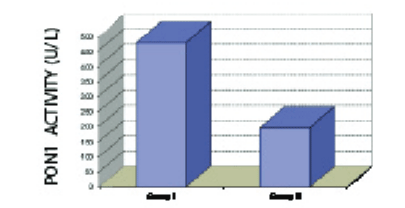
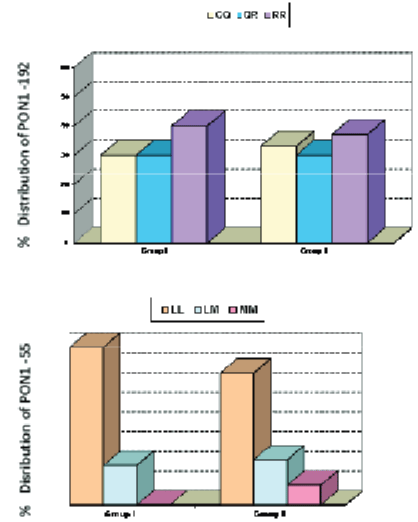
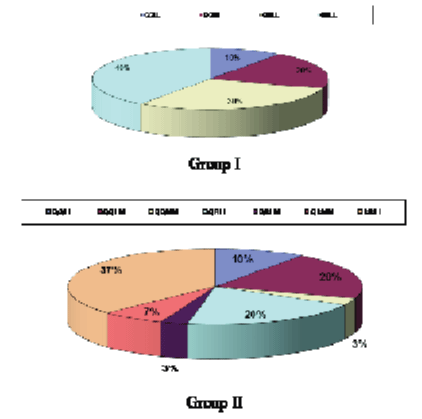
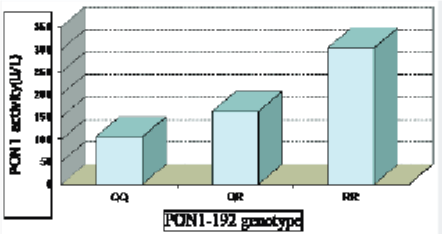
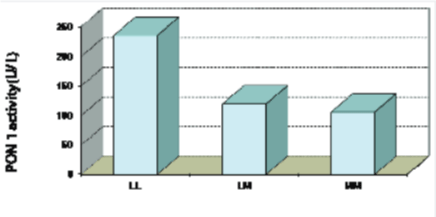

 Save to Mendeley
Save to Mendeley
